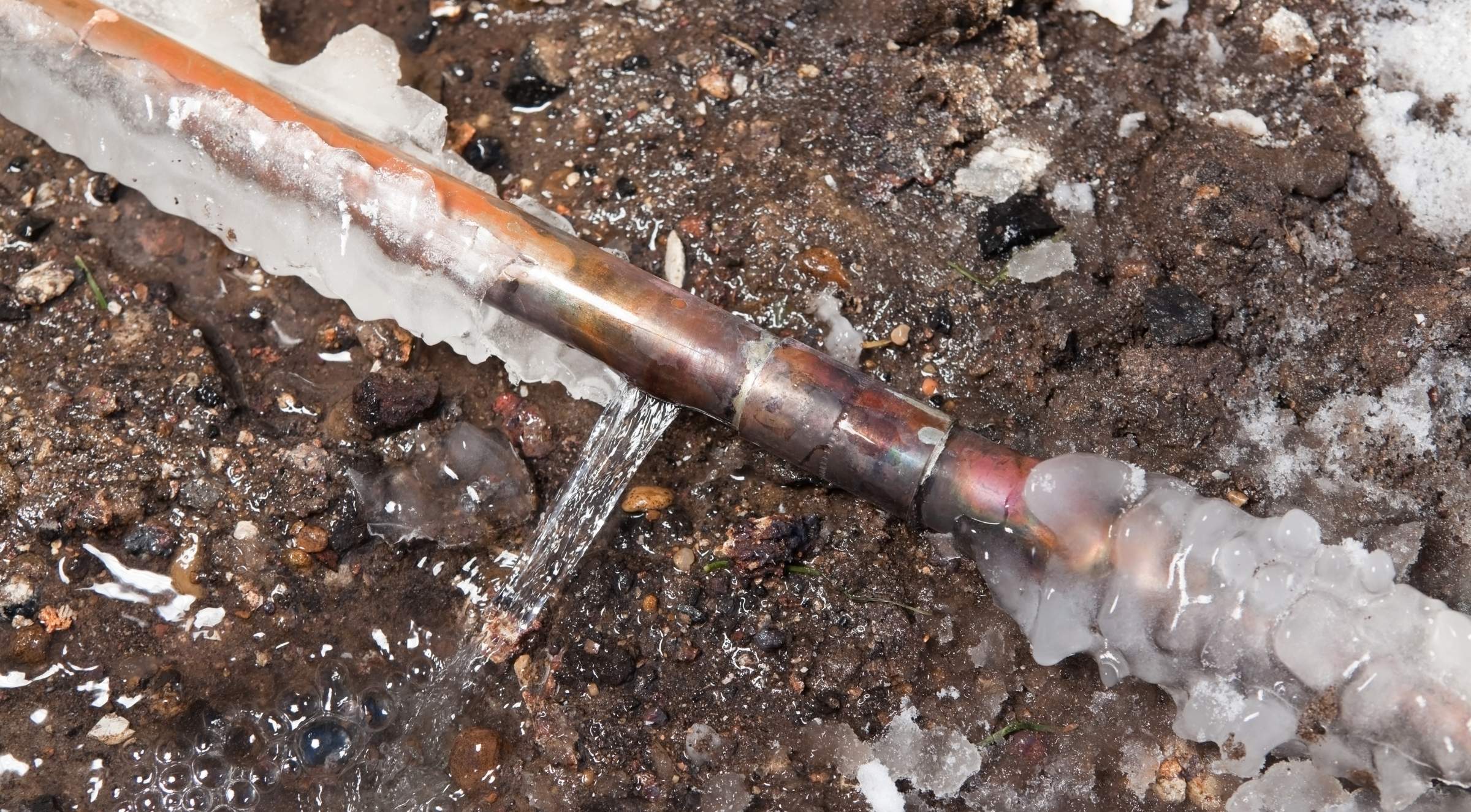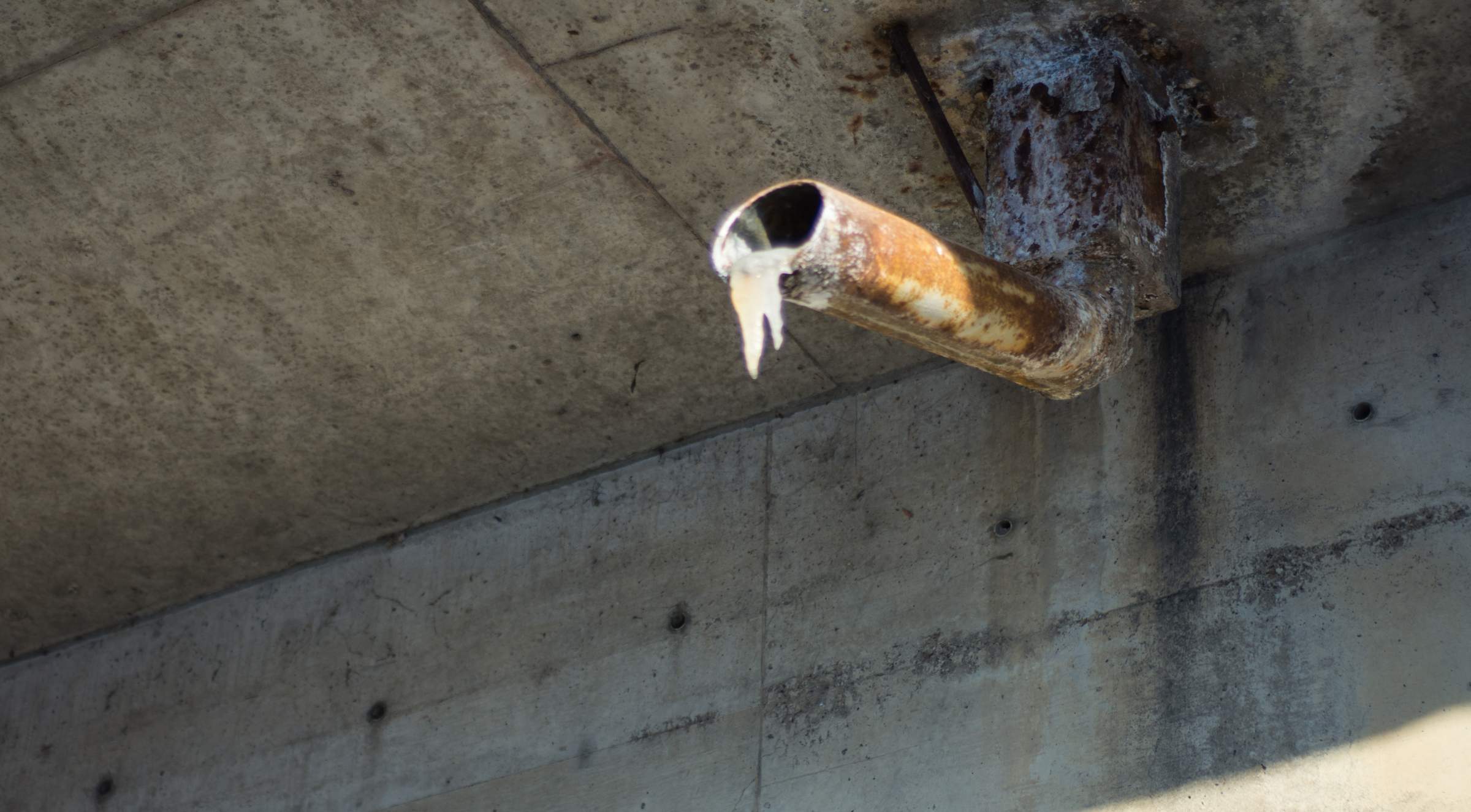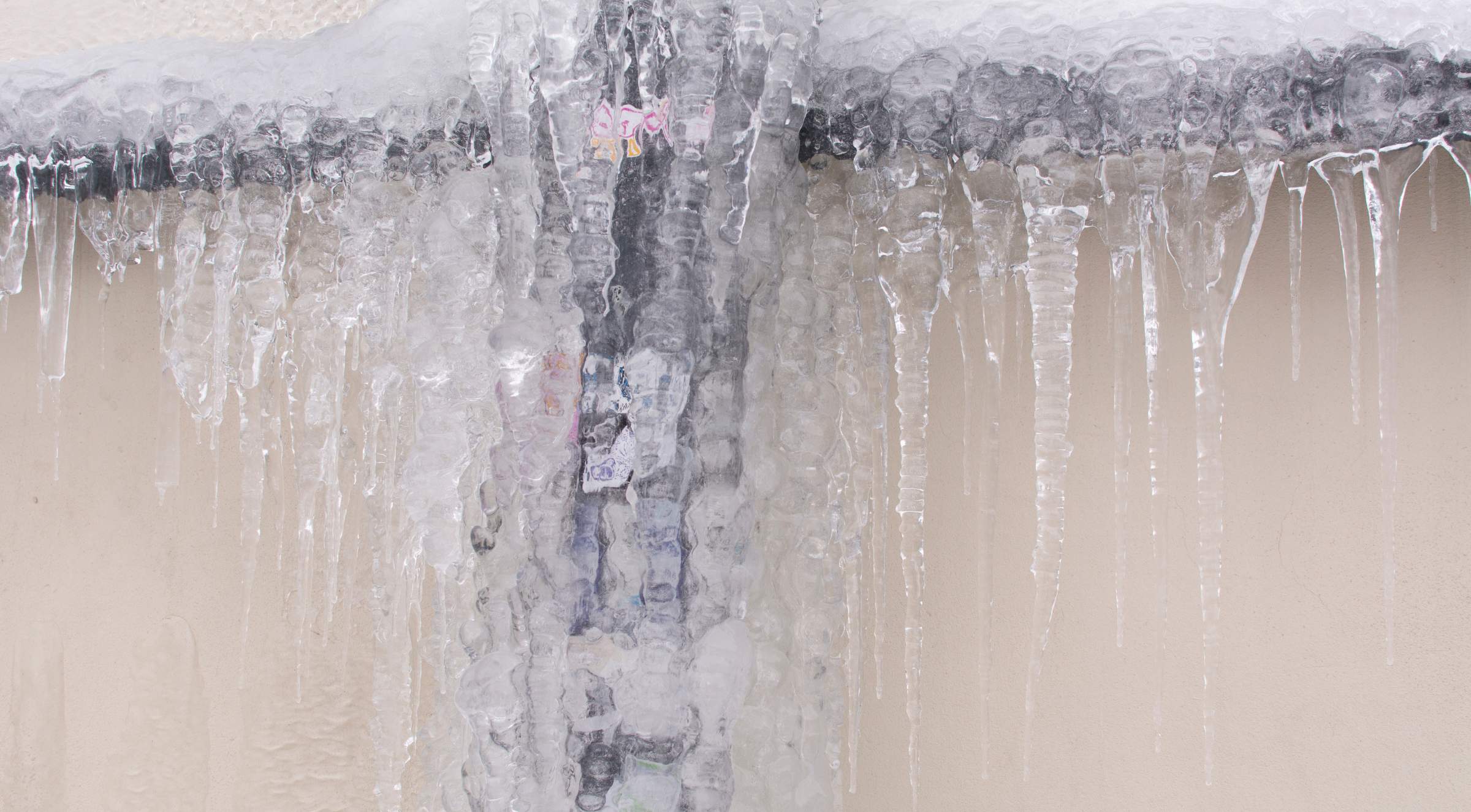Before a cold snap, everyone reminds each other to keep the faucet trickling to keep the pipes from freezing. If it hasn’t happened to you yet, you probably know someone who’s had to deal with frozen pipes. Ruined appliances, flooding, water damage, mold — these are a few of the specters that surround the prospect of frozen pipes.
What if that prospect becomes reality? What do you do if your pipes freeze? Your first instinct might be to panic, but forearm yourself with knowledge about the proper response, and you could save yourself thousands of dollars.
Pure Environmental explains here how to recognize and handle frozen pipes — whether they have ruptured or not — and how you can take action to protect your home from further damages.
Table of Contents
- How Do You Know if Your Pipes Are Frozen?
- What Should I Do if My Pipes Are Frozen?
- Will Frozen Pipes Thaw On Their Own?
- 5 Steps To Take if Your Pipes Freeze
- What To Do When Your Pipes Rupture or Burst
- PURE Environmental Provides Emergency Mitigation Services for Homes and Businesses Throughout Greater Portland, OR, and Tacoma, WA
How Do You Know if Your Pipes Are Frozen?
The telltale sign that your pipes have frozen is that your faucet only lets out a trickle of water or none at all when you turn it on full blast. You might also notice any of the following:
- Frost on the outside of an exposed pipe
- Bulges or cracks in a pipe with ice seeping out
- Banging, gurgling, or whistling sounds from inside the pipes
- Dampness on drywall or the ceiling
- Peeling or bubbling paint or wallpaper
If you suspect there may be a frozen pipe and you are unable to confirm it because your pipes are not exposed, call Pure Environmental to have a technician come and inspect your plumbing.
What Should I Do if My Pipes Are Frozen?
Take these steps if you suspect your pipes have frozen:
- Turn off the main water line.
- Find the frozen pipe(s).
- Thaw the pipe(s).
- Check the pipe(s) for leaks.
- Contact a professional plumber or home restoration company, such as Pure Environmental.
Will Frozen Pipes Thaw On Their Own?
When the temperature around the pipes rises above freezing, they will thaw on their own without any intervention on your part. You can speed up the process by placing a safe heat source near the pipes.

5 Steps To Take if Your Pipes Freeze
#1: Shut Off the Water
Turn off the water main that leads into your home to prevent flooding and water damage in the event that the pipes burst. Next, open the faucet or faucets connected to the affected pipe to reduce the pressure inside it. If the pipe bursts, this will keep flooding to a minimum.
#2: Find the Frozen Pipe
Frozen pipes are generally found in unconditioned or poorly insulated areas, such as:
- Basement
- Crawl space
- Attic
- Inside an exterior wall
- Under a sink
There is often frost visible on the exterior of a frozen pipe. This is a clear sign that the pipe needs attention.
#3: Thaw the Pipes
If you can reach the frozen pipe, there are several ways you can thaw the ice blockage:
- Use a hair dryer or space heater.
- Wrap towels soaked in hot water around the pipe.
- Use an infrared lamp.
- Turn up the thermostat and wait for it to thaw.
Never use a heat source with an open flame — such as a blowtorch or propane heater — and be sure to keep any electric heat sources away from walls where they could start a fire.
Keep the faucet open so that, as the ice melts, the running water can help melt the frozen area. Apply the heat source until the faucet puts forth full water pressure.
To find other frozen pipes in your home, see if any of the other faucets have reduced or no water pressure.

#4: Check the Pipe for Leaks
Although the water main is turned off, you can still observe leaks in exposed pipes. If the pipe is still frozen, you may see frost, ice, bulges, or cracks. If the pipe has thawed, the melting ice will begin to run out of any leaks.
Other steps you can take to determine if there are leaking pipes include:
- Check the water meter after turning off the water main and turning off all faucets and appliances that use water. If the meter reports any usage at all, you may be dealing with a leak — the greater the usage changes, the faster the leak.
- Monitor your water usage as indicated on your water bill. If your bill rises but your water usage habits have not, or if you notice that your usage is over 12,000 gallons per month, you may be dealing with a leak. This leak could be located underground, where you cannot detect it, but you are still responsible for any leakage that is past the meter. A professional plumber should inspect your plumbing system to ascertain the presence of a leak. Even small leaks should not be overlooked, as they can result in exorbitant waste of water over the course of a month.
- Check to see if your toilets are running properly. Put a few drops of food coloring into the toilet tank. If the color shows up in the toilet bowl after ten minutes, there is a leak.
- Check periodically under faucets and basins for any signs of leakage, such as mold growth or foul smells. If your plumbing system is over 25 years old it may be nearing the end of its lifespan, so be especially vigilant for leaks.
#5: Contact a Professional Plumber
To ensure your pipes are thawed properly and that all leaks are located, contact a professional plumber. They will have pipe-thawing equipment and can make any necessary repairs if your pipes are damaged.
Whether you notice any leaks or not, it is helpful to have a plumber examine your pipes in case a hard freeze causes stretching and fatigue that can weaken them and cause problems in the future.
Pure Environmental provides pipe repair as well as mitigation of hazardous situations so you can avoid catastrophes due to improper maintenance in your home.
What To Do When Your Pipes Rupture or Burst
Shut Off the Water
If your pipes burst, your house is already flooding. Your first priority, in this case, is to preserve your home’s structure and your belongings by stopping the flow of water.
Ideally, you have (or can install) a shutoff button that turns off the water to the entire house. The laundry room is a great place for this. If this is not an option, be sure you know ahead of time where the shutoff is located.
It is fortunate to notice a cracked pipe before it actually bursts because as you thaw it, you’ll only need to deal with the water that is above the rupture in the line. But if you don’t shut off the water main before the pipe bursts, six gallons of water can enter your house each minute, in addition to all the water in the lines above the busted area. If this scenario happens, thawing out your pipe is the least of your worries.
Contact Your Insurance Company
Broken pipes, especially those located inside, are typically covered by insurance, but there are some exceptions. One may be when the pipe breaks outside and water makes its way inside.
Your insurance will probably cover the cost of cleaning, repairing, or replacing wood flooring, drywall, or furniture damaged by water from pipes that burst suddenly and unexpectedly.
However, if your pipes froze because you turned your house thermostat down before leaving your home for several days, or if damage resulted from a known leak or other long-standing problem, your claim may not be approved for coverage.
To prevent this from happening while you are away from home, set your thermostat no lower than 55 degrees and consider asking a trusted friend to check that the heat is still running properly. If you will be gone for the whole winter, you’ll need to winterize your home. This will mean, among other things, draining your plumbing system and turning off the water main.
Discuss with your insurance agent what kinds of coverage you will need in the event of burst pipes. It will probably include:
- Dwelling coverage: Helps cover the cost of reconstruction or repair of your home’s physical structure.
- Personal property coverage: Helps cover the costs of replacement or restoration of your belongings.
- Loss of use coverage: Helps cover the cost of alternative living arrangements if your home is temporarily uninhabitable.
Call a Restoration Company
If you don’t call someone to get the water cleaned up and your house dried out quickly and correctly, you could cause permanent damage and/or mold growth. The faster you get professional help, the more money you can save.

PURE Environmental Provides Emergency Mitigation Services for Homes and Businesses Throughout Greater Portland, OR, and Tacoma, WA
Pure Environmental is a trusted emergency mitigation and restoration company serving the Portland and Tacoma areas. Our customers attest to our thoroughness, professionalism, and commitment to excellent work using the safest, most sustainable technologies.
Our team can perform all the tasks needed for restoring homes damaged by water, mold, or fire, or plagued with pests and dangerous airborne contaminants. We repair leaks and burst pipes and remove water that has leaked or flooded into your home. This is critical to maintain the safety and cleanliness of your home after burst pipes.
Anytime moisture remains in the home for more than 24 hours, mold has a chance to grow and spread. Mold inspection and treatment goes hand in hand with addressing plumbing issues.
If mold has taken hold in your home, we will inspect the premises to determine the extent and type of damage. Then we perform expert cleaning and repairs/replacement as well as purification with our PurAyr treatment to ensure your home is free of mold. We can also advise you about how to prevent mold growth.
Allow Pure Environmental the pleasure of serving your home remediation needs. Call us today to schedule an initial inspection and/or receive an estimate of the cost of service.
Recent posts
- Pros and Cons of Heat Treatment for Bed Bugs: Things To Consider When Reviewing Your Options for Remediation
- How To Get Rid of Pet Odor in Your House
- Clearing the Air: How To Clean Walls From Cigarette Smoke
- Deodorizing Your Living Space: How To Get Rid of a Musty Smell in Your House
- How Do You Get Rid of Mold in Your Attic? Tips from the Professionals
Recent Posts
- Pros and Cons of Heat Treatment for Bed Bugs: Things To Consider When Reviewing Your Options for Remediation
- How To Get Rid of Pet Odor in Your House
- Clearing the Air: How To Clean Walls From Cigarette Smoke
- Deodorizing Your Living Space: How To Get Rid of a Musty Smell in Your House
- How Do You Get Rid of Mold in Your Attic? Tips from the Professionals
